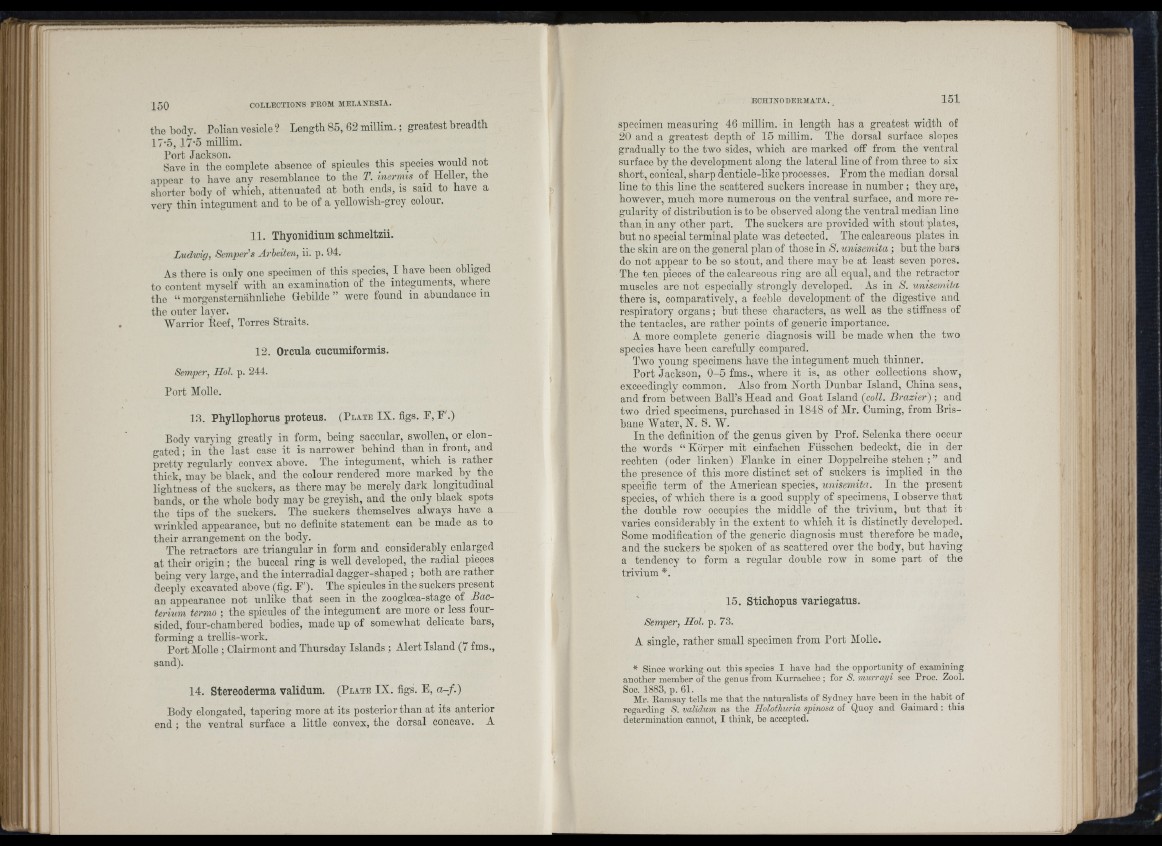
the bodjL Polian vesicle ?
17-5, 17-5 millim.
Port Jackson. . ,
Save in the complete absence of spicules this species would not
aiipear to liave any resemblance to the T. inermis of Heller, the
shorter body of which, attenuated at both ends, is said to have a
very thin integument and to be of a yeUowish-grey colour.
11. Thyonidium schmeltzii.
Ludioiy, Semper’s Arbeiten, ii. p. 94.
As there is only one specimen of this species, 1 have been obliged
to content myself with an examination of tho integuments, where
the “ morgei7stermihnliche Gebilde ” were found iu abundance in
the outer layer.
Warrior llcef, Torres Straits.
12. Orcula cucumiformis.
Semqier, Hoi. p. 244.
Port Molle.
13. PhyUophorus proteus. (P late IX. figs. F, F'.)
Body varying greatly in form, being saccular, swollen, or elongated
; in the last case it is narrower behind than in front, and
pretty regiilarlj' convex above. The integument, which is rather
thick, may be black, and the colour rendered more marked by the
lightness of the suckers, as there may be merely dark longitudinal
bands, or the whole body may be greyish, and the only black spots
tho tips of the suckers. The suckers themselves always have a
wrinkled appearance, but no definite statement can be made as to
their arrangement on the body.
The retractors are triangular in form and considerably enlarged
at their origin ; the buccal ring is well developed, the radial pieces
being very "large, and the interradial dagger-shaped ; both are rather
deeply excavated above (fig. F'). The spicules in the suckers present
an appearance not unlike th at seen in the zoogloea-stage of Bacterium
termo ; the spicules of the integument are more or less foursided,
four-chambered bodies, made up of somewhat delicate bars,
forming a trellis-work.
Port Molle ; Clairmont and Thursday Islands ; Alert Island (7 fms.,
sand).
14. Stereoderma validum. (P late IX. figs. E, a -f.)
Body elongated, tapering more at its posterior than at its anterior
end ; tho ventral surface a little convex, tho dorsal concave. A
specimen measuring 46 millim. in length has a greatest width of
20 and a greatest depth of 15 millim. The dorsal surface slopes
gradually to the two sides, which are marked off from the ventral
surface by the development along the lateral line of from three to six
short, conical, sharp donticle-like processes. From the median dorsal
line to this line the scattered suckers increase in number ; they are,
however, much more numerous on the ventral surface, and more regularity
of distribution is to be observed along the ventral median line
than in any other part. The suckers are provided with stout plates,
but no special terminal plate was detected. The calcareous plates in
the skin are on the general plan of those in S. unisemita ; but the bars
do not appear to be so stout, and there may be at least seven pores.
The ten pieces of the calcareous ring are all equal, and the retractor
muscles are not especially .strongly developed. As in S. unisemita
there is, comparatively, a feeble development of the digestive and
respiratory organs; but these characters, as well as the stiffness of
the tentacles, are rather points of generic importance.
A more complete generic diagnosis will be made when the two
species have been carefully compared.
I ’wo young specimens have the integument much thinner.
Port Jackson, 0 -5 fms., where it is, as other collections show,
exceedingly common. Also from North Dunbar Island, China seas,
and from between Ball’s Head and Goat Island (coll. Brazier) ; and
two dried specimens, purchased in 1848 of Mr. Cuming, from Brisbane
Water, N. S. W.
In the definition of the genus given by Prof. Selenka there occur
the words “ Körper mit einfachen Fässchen bedeckt, die in der
rechten (oder linken) Flanke in einer Doppelreihe stehen ; ” and
the presence of this more distinct set of suckers is implied in the
specific term of the American species, unisemita. In tho present
species, of which there is a good supply of specimens, I observe that
the double row occupies the middle of the trivium, but th at it
varies considerably in the extent to which it is distinctly developed.
Some modification of the generic diagnosis must therefore be made,
and the suckers he spoken of as scattered over the body, but having
a tendency to form a regular double row in some part of the
trivium *.
15. Stichopus variegatus.
Semper, Hoi. p. 73.
A single, rather small specimen from Port Molle.
* Since working out this species I have had the opportunity of examining
another member of the genus from Kurrachee ; for S. murrayi see Proc. Zool.
Soc. 1883, p. 61.
Mr. Earasay tells me that the naturalists of Sydney have been in the habit of
regarding 3. validum as the Holothuria spinosa of Quoy and Gaimard ; this
determination cannot, I think, be accepted.
ll I: ’ ! 1
,
A ! !
G .ilhi ..,
V . 1
li ! (
( 1
r ■ ' ’
1
! 1
1
' ll
! !'
i
' '‘ f- I I
li IIh'M !